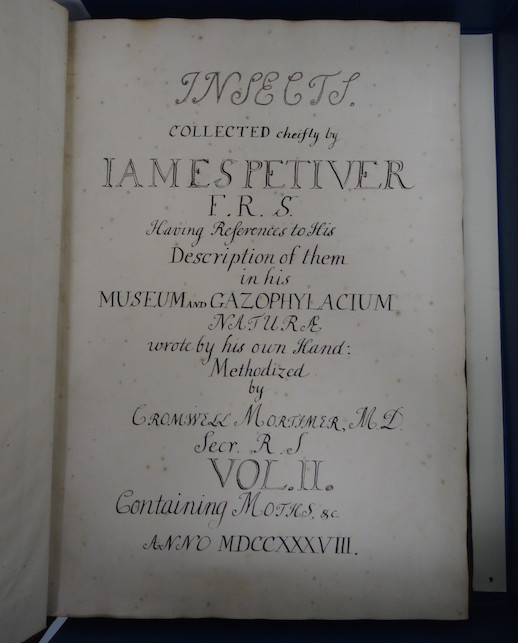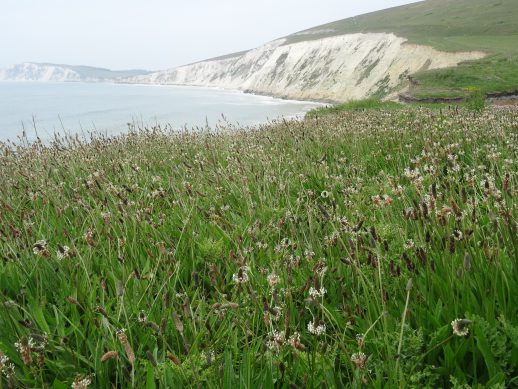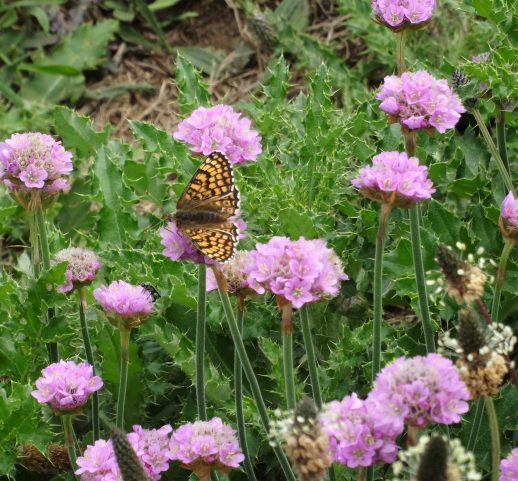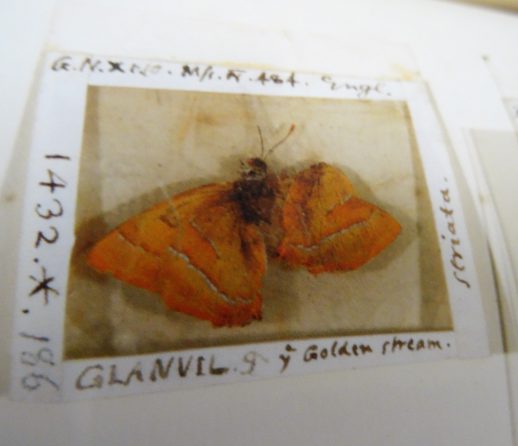Sue Brooks delves into the history of butterfly collecting, and goes in search of an increasingly rare species
February 2nd and I’m following Geoff Martin down twisting staircases and narrow corridors in the bowels of the Natural History Museum. Another chapter in a fascination with one particular butterfly – the Glanville Fritillary – which started when I read a short comment in The Aurelian Legacy (Michael Salmon 2000) about the woman who discovered it. Her noble collection probably perished long ago, but very recently three specimens she gave to Petiver, a butterfly and two moths were refound in the Sloane collection in the Natural History Museum. Lost and refound. The detective in my brain swung into action. The butterfly recently rediscovered in the Sloane collection must be a 300 year old Glanville Fritillary miraculously preserved in a drawer, in some storage centre closed to the public. I made enquiries, and booked an appointment and a day ticket to South Kensington. It felt exciting to be on the trail.
Eleanor Glanville was born in 1654. She died in 1709 aged 55. There is no portrait of her and very few records. What a time that must have been for any naturalist. The early collectors could walk a short distance into the countryside and see an abundance of insects unimaginable to us now. New species were discovered in vicarage gardens, captured, named and displayed in cabinets: details of food plants, number of instars, (the shedding of skin by growing larvae) the differences between males and females, how they survive the winters. A passion, a love of beauty, and wonder at the sheer variety of colour and form revealed by close observation. They met together in coffee houses in London to admire collections and devices for capturing, killing and preserving specimens. There are one hundred and one names in The Aurelian Legacy. Moses Harris, Vauncey Harpur Crewe, Edward Bagwell Purefoy, John Obidiah Westwood, Dru Drury. I speak them aloud as I write. Only four are women: Eleanor Glanville, Letitia Jermyn (1788 – 1848) Emma Hutchinson (1820 – 1906) and Margaret Fountaine (1862 – 1940). All made important contributions. Letitia Jermyn wrote The Butterfly Collector’s Vade Mecum, Emma Hutchinson became the recognised expert on the Comma butterfly, and Margaret Fountaine travelled the world with her Syrian lover in search of exotic species. Eleanor Glanville is the only woman to have a butterfly named after her. The greatest honour of all.
Latin names are accredited to Linnaeus after 1758, but the English names went through many changes depending on the individual collector, until settling on the ones in current use. Interestingly, the butterfly discovered by Eleanor Glanville in Lincoln in 1702 only went through three variations before being generally described as the Glanville Fritillary from 1748, forty years after her death. No other British butterfly is commemorated by the person, male or female, who discovered it. Eleanor Glanville, working on her vast estates in Somerset and Lincolnshire with her housemaids, had no idea she would be immortalised in this way. She corresponded avidly and sent specimens to other collectors, and there is one reference to a chance meeting in London with a remarkable lady from the West Country with the noblest collection of butterflies, all English, which has sham’d us. The honour cannot be overstated. She was regarded by her contemporaries as an outstanding naturalist.
Lost and refound. It seems to have been the pattern for this butterfly across three centuries. After the discovery in Lincolnshire, it was never widely seen and by the late 1860s had disappeared even from favoured sites around Folkestone. Only to be rediscovered on the Isle of Wight, on the cliffs and downs of the southern coast. In my Field Guide, the distribution is shown as a tiny patch of orange in an otherwise grey map of the UK. The last toehold of the Glanville Fritillary.
June 6th 2016, the morning of my first day at Compton Farm. A butterfly heaven. Acres of chalk downland owned by the National Trust and managed for the utmost diversity. The grasses on the slope above the empty camping field are two feet tall, interspersed with patches of Horseshoe Vetch, (foodplant of Adonis Blue) the yellow cottony heads of Kidney Vetch (Small Blue) and Rock Rose (Brown Argus) at the edges of the paths. I set off with umbrella and binoculars for the Undercliff. Across the road and down the steep wooden steps. Glanvilles are said to favour bare ground colonised by bird’s foot trefoil and thrift, south facing for maximum warmth. There is maximum warmth long before midday; 90 degrees with no shade except the umbrella and my shadow, moving very slowly. Surprisingly few flowering plants and vast expanses of bare, baked soil. I take refuge in the van and listen to the weather forecast. A heat wave has hit the whole country and will last at least a week.
June 7th and I’m out early for the only other place mentioned in the Field Guide. A short section between the Undercliff and Compton Chine. I take the path beside a wire fence, with the road a few yards away and the cliff edge five paces to my left. The sea is a white hot mirror. There is no trace of breeze. The tingling sensation begins. I can see that the land begins to widen. From where I stand to the Chine, perhaps 20 yards ahead, it’s much more than 5 paces – 15 or 20 paces – and a miniature forest seems to have grown there. Dark green with pale seed heads and an understorey of pink tussocks in full bloom. Ribwort Plantain and Sea Pinks, the larval foodplant and favourite nectar plant of the Glanville Fritillary. A Nabokov Moment. More than a moment, an hour, two hours, while I stand, clutching the umbrella, and no cars pass on the road, no walkers along the path, no dogs or cyclists – or so it is in my memory – and watch 20 or more butterflies feasting and cavorting. Now I know exactly what the Glanville Fritillary likes and it is no ordinary Plantain, not the broad leaved variety, and not the kind I have previously known as Ribwort. It is astonishingly vigorous, the leaves long and pointed, the seed heads held high on supple stems. The same with the thrift. The tussocks are like large anthills, the flowers carry dozens of miniature florets. A tiny oasis of soil, salt and sun – the best the UK has to offer. Thoughts of extinction cross my mind, but I recall from another Field Guide that although numbers are in decline, the Glanville Fritillary is fairly widespread across Europe: as far as Russia and Mongolia. In a way, this makes its presence here, still hanging on to a favoured piece of Albion, even more extraordinary. I watch them continually on the move, manoeuvring around the thrift flowers, tipping their bodies this way and that to angle the proboscis deep into the heart and drink the nectar. Males tangle with males; males approach females and there is much wing fluttering. Painted Ladies gatecrash and are mobbed off by a group of Glanvilles. It’s one of those peak days when humidity, temperature, pressure, and wind direction are perfect for butterflies. I gave up counting the number of Painted Ladies I saw that day. My great and unforgettable good fortune.
Fast forward to a laboratory in the Natural History Museum, where Geoff tells me I must leave my coat and bag before we enter the collection area. I can take my camera. Another locked door and we are surrounded by high steel cabinets. The air smells strange and sounds are deadened by it. Temperature control, he says. We have 11 million specimens and it’s a constant struggle against pest infestation. A side door into a cubicle with wide, shallow drawers. Geoff checks the label and pulls out a white box. He opens the lid and removes a leather covered book of massive dimensions – 18 by 24 by 3 inches thick. He opens the cover and turns the pages, looking for a particular image. Too quickly. He stops and there, on an otherwise empty, age-mottled page of thick paper, is a tiny brown insect, no more than an inch square, with half a wing missing. 2090 is written in the top margin. GLAN ENGL in the bottom. There are two others, Geoff says, and turns more pages. He shows me 5216 GLAN and 1432 GLANVIL Golden Stream. (2090 is a Figure of Eight moth, 5216 a Mottled Umber moth and 1432 the early name for what is now known as the Brown Hairstreak).
There are no Glanville Fritillaries. The Golden Stream, flattened between two sheets of mica by James Petiver, is the only butterfly survivor of Eleanor Glanville’s vast collection. I can’t say my heart leapt, because it didn’t. The poor scrap of a thing. Was the detective disappointed? Only momentarily. I had misread the clue and created a story. That was all. What was in front of my eyes was far more exciting. The evidence of how it might have felt to see without the microscopes, lenses and all the paraphernalia we have now. To link for the first time, gazophylacium (a place where precious items are deposited as a treasury), metamorphosis and Vade Mecum with flyes and worms.
Three centuries later, it’s easy to lose touch with excitement in the natural world, and feel mostly sadness and despair, but at the end of the trail, going home on the bus, I know 2017 is going to be different. Some day soon I will see the first butterfly of the year – a Brimstone or a Small Tortoiseshell or an early Red Admiral. The ghosts of James Petiver and Eleanor Glanville will be in attendance. Eleanor may be carrying her parasol. It will be thrilling as never before.



